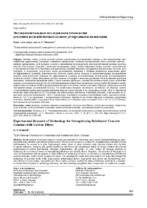| dc.description.abstract | Обычно, чтобы усилить колонну (пилон), увеличивают ее поперечное сечение за счет наращивания, инъецирования укрепляющих растворов и внешнего армирования. Наиболее прогрессивный метод усиления сегодня – внешнее армирование, суть которого состоит в наклеивании на поверхность конструкций высокопрочных полотен, пластин или полосок (ламелей) с помощью специальных клеев. Особое внимание ученые уделяют теоретическим и экспериментальным исследованиям конструктивных решений внешнего армирования вертикальных несущих конструкций. К сожалению, результатов таких исследований, например о влиянии технологии выполнения работ на эффективность усиления, фактически нет. Поэтому задача автора состояла в экспериментальных исследованиях влияния технологических факторов на эффективность усиления железобетонных конструкций, воспринимающих усилия на сжатие. Опыты выполнены шестью сериями, в которых с помощью различных технологических факторов изменялась технология проведения работ. Среди основных факторов: наличие/отсутствие острых углов, подготовка основы (грунтование поверхности), способ приклеивания армирующих материалов к конструкции. Критерием оценки эффективности технологии была разрушающая прочность на осевое сжатие усиленных образцов. Анализ результатов экспериментальных исследований показал, что наибольшая несущая способность достигалась на образцах колонн с округленными углами при условии нанесения клея на основу образца и на углеродное волокно (40,6 т). Прочность на сжатие таких образцов на 82,2 % больше, чем контрольных. Прочность усиленных образцов, углы которых не закругляли, оказалась наименьшей – 34,0 т. Для образца, усиленного волокном, пропитанным клеем, показатель увеличился на 74,3 % по сравнению с контрольными образцами. Прочность на сжатие образцов, усиленных углеродным волокном, приклеенным к предварительно нанесенному на основание клею, составила 38,6 т, что на 73,4 % больше, чем прочность контрольных образцов. | ru |
| local.description.annotation | Reinforcement of columns (piers) is usually accomplished by increasing cross-section through building-up, injecting reinforcing solutions and external reinforcement. The most and progressive method for strengthening is currently external reinforcement, its essence is to glue high-strength sheets, plates or strips (lamellas) onto structure surface with the help of special adhesives. Scientists pay special attention to theoretical and experimental studies of design solutions for external reinforcement of vertical load-bearing structures. Unfortunately, the results of such studies, for example, influence of technology for execution of works on strengthening efficiency are virtually absent. Therefore, the objective of this paper is to carry out experiments with the purpose to study influence of technological factors on efficiency in strengthening of reinforced concrete structures, which absorb compressive forces. The experimental studies have been made in six series that changed the technology of executed works while using various technological factors. Among the main factors are the following: presence/ absence of acute angles; preparation of a base (surface coating); method for gluing reinforcing materials to a structure. A criterion for evaluation of technology efficiency has been breaking strength for axial compression of reinforced samples. Analysis on the results of experimental studies has shown that the highest load-bearing capacity is achieved while using samples of columns with rounded edges, provided that an adhesive is applied to sample base and carbon fiber (40.6 tons). The compressive strength of such samples is by 82.2 % higher than the strength of control samples. The strength of reinforced specimens with non-rounded edges has appeared to be the lowest one, namely 34.0 tons. Strengthening of the samples with fiber impregnated with an adhesive has increased the indicator by 74.3 % compared to the control samples. The compressive strength of samples reinforced with carbon fiber adhered to the adhesive which is preliminary spread on the basis is equal to 38.6 tons, which is by 73.4 % higher than the strength of the control samples. | ru |

